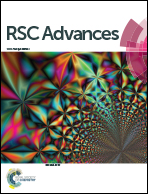Steering protein adsorption at charged surfaces: electric fields and ionic screening†
Abstract
Protein adsorption at charged surfaces is a common process in the development of functional technological devices. Accurately reproducing the environment above the surface in simulations is essential for understanding how the adsorption process can be influenced and utilised. Here we present a simulation strategy that includes the electric field above the charged surface as well as the screening ions in solution, using standard molecular dynamics tools. With this approach we investigate the adsorption of Hen Egg White Lysozyme (HEWL) onto a model charged silica surface. We find that the screening effects of the ions slow down the adsorption process, giving the protein more time to find its optimal orientation as it adsorbs. Furthermore, we find that the concentrated ionic region directly above the surface helps to stabilise the protein structure in its adsorbed state. Together these effects imply that the adsorbed HEWL might retain its biological activity, with its active site exposed to solution rather than to the surface. Furthermore, this work shows how the steering effects of the electric field, coupled to the ionic screening, might be used to develop general strategies for surface functionalization through protein adsorption for technological applications.


 Please wait while we load your content...
Please wait while we load your content...